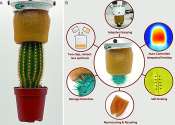Soft robot detects damage, heals itself (video)
Cornell University engineers have created a soft robot capable of detecting when and where it was damaged—and then healing itself on the spot.
Dec 7, 2022
0
147
Robotics

Cornell University engineers have created a soft robot capable of detecting when and where it was damaged—and then healing itself on the spot.
Dec 7, 2022
0
147
Engineering

Ceramics are resilient to heat and extreme environments, but they are fragile and crack easily. Recently, in a study published in Science Advances, researchers at Texas A&M University have discovered a self-healing mechanism ...
Sep 10, 2021
0
51
Robotics

Researchers have developed a self-healing robotic gripper for use in soft robotics that is adaptable, recyclable and resilient to damage, thanks to heat-assisted autonomous healing.
Nov 27, 2023
0
55
Engineering

Each year, roughly 6 million Americans break a bone and head to their doctor for a plaster or fiberglass cast. After six long weeks of keeping the cast dry and resisting the urge to scratch the skin underneath, the patients ...
Sep 23, 2021
0
46
Engineering

A team of engineers led by Tufts University has developed a prototype bandage designed to actively monitor the condition of chronic wounds and deliver appropriate drug treatments to improve the chances of healing. While the ...
Jul 6, 2018
0
108
Engineering

Engineering researchers have developed a new self-healing composite that allows structures to repair themselves in place, without having to be removed from service. This latest technology resolves two longstanding challenges ...
Oct 31, 2022
0
163
Engineering

Roads always seem to need repairs. Luna Lu is giving concrete the ability to "talk" and even heal itself.
May 20, 2020
0
7
Engineering

Safety issues of self-driving cars have emerged due to frequent traffic accidents. A self-healing lens material that can prevent car accidents that occur due to signal distortion by healing scratches on the sensor surface ...
May 22, 2023
0
89
Energy & Green Tech

A team led by Prof. Hu Linhua at the Hefei Institutes of Physical Science of the Chinese Academy of Sciences (CAS) has recently developed a type of self-healing perovskite solar cell by functional combination of polyvinylpyrrolidone ...
Dec 28, 2021
0
46
Robotics

A new study assesses the maximum number of damage and healing cycles a self-healing actuator can endure. The study, which presents a method to automatically and autonomously assess the repeatable healability of a soft self-healing ...
Oct 31, 2023
0
10
Physiological healing is the restoration of damaged living tissue, organs and biological system to normal function. It is the process by which the cells in the body regenerate and repair to reduce the size of a damaged or necrotic area. Healing incorporates both the removal of necrotic tissue (demolition), and the replacement of this tissue.
The replacement can happen in two ways:
Most organs will heal using a mixture of both mechanisms.
This text uses material from Wikipedia, licensed under CC BY-SA